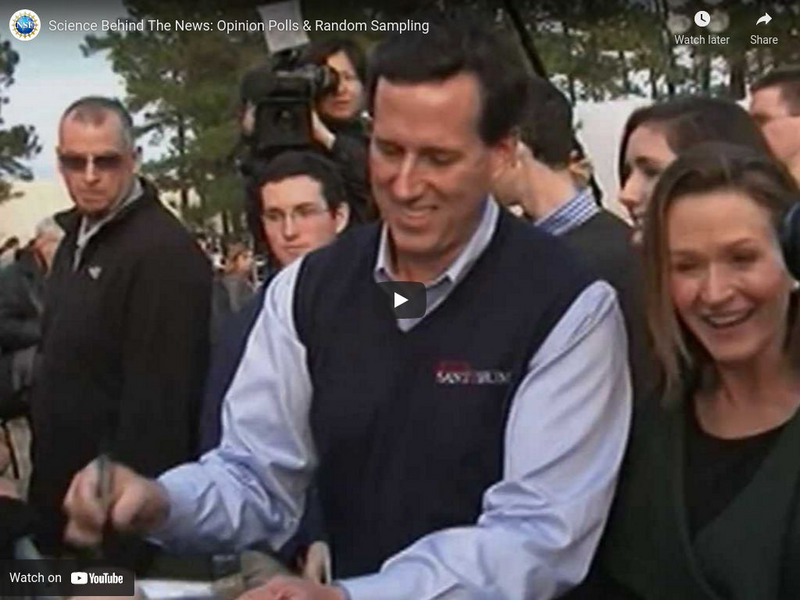National Science Foundation
National Science Foundation: Science of Nhl Hockey: Reflexes & Reaction Time
An NHL goalie relies on his brain even more than his equipment in order to stop a puck with split-second timing. How a goalie does that is described in this video. [5:26]
National Science Foundation
National Science Foundation: Science of Nhl Hockey: Newton's Three Laws of Motion
Scientists explain how Newton's Three Laws of Motion manifest themselves in a game of hockey. [5:32]
National Science Foundation
National Science Foundation: Science of Innovation: Electronic Tattoo
An electronic tattoo can attach right to the skin and continuously monitor a person's health. It came about as a collaboration between two scientists from different fields of expertise. Its adhesive properties were inspired by a gecko's...
National Science Foundation
National Science Foundation: Science of the Winter Olympics: Olympic Motion
Dan Fletcher, a bioengineer, studies the movement of cells in the human body. He explains that it is practice that causes muscles to organize themselves for peak performance in an athlete. [5:39]
National Science Foundation
National Science Foundation: Science of Innovation: Synthetic Diamonds
Scientists value diamond for its unique properties and some researchers can only use diamond in their experiments. Scientists have been able to create a new type of synthetic diamonds that are larger and have properties that can be...
National Science Foundation
National Science Foundation: Science of Nhl Hockey: Statistics & Averages
In order to be the best at their game, an NHL goalie must understand the statistics of their performance, and of their competition, e.g., the goalie save percentage and the goals against average. [5:56]
National Science Foundation
National Science Foundation: Science of Innovation: What Is Innovation?
See how the process of innovation happens. This series of steps begins with imagination, and results in the creation of something of value for society. [6:56]
National Science Foundation
National Science Foundation: Spherical Nucleic Acids
An overview of how the properties of Spherical Nucleic Acids make them favorable for therapeutic treatments and medical diagnostics. [3:41]
National Science Foundation
National Science Foundation: Science of Innovation: Anti Counterfeiting Devices
Scientists are researching methods of embedding biomarkers into products to identify them as real as opposed to counterfeit items, using nanotechnology. [5:50]
National Science Foundation
National Science Foundation: Science of Nhl Hockey: Hockey Geometry & Science
This 10-part video series explores the science and math behind professional hockey.
National Science Foundation
National Science Foundation: Science of Nhl Hockey: Force, Impulse & Collisions
The movement of a puck in an NHL hockey game must follow the rules of physics, which involve the concepts of force, impulse and collisions. [5:05]
National Science Foundation
National Science Foundation: Science Behind the News: Opinion Polls & Random Sampling
Explains the science behind the public opinion polls and random sampling that are used during political elections, and how they can be used to predict how the wider population might vote. [4:07]
National Science Foundation
National Science Foundation: Science of the Winter Olympics: Slapshot Physics
One of the most popular team sports in the Winter Olympics is hockey. More than just a physical game, for scientists, it's a showcase for physics on ice - especially when it comes to the slapshot. An Olympian and two scientists break...
National Science Foundation
National Science Foundation: Science of the Winter Olympic Games: Science of Snow
Snow is an essential part of the Winter Olympics. A former Winter Olympian, who is also a glaciologist, and a chemist discuss how humidity and temperature help form snow. [4:40]
National Science Foundation
National Science Foundation: Green Revolution: Solar
At Arizona State University, students make and test new materials that can be used to build better and more versatile photovoltaic solar cells, and test solar cells to see how the shape of the surface affects the cell's energy...
National Science Foundation
National Science Foundation: Green Revolution: Wind
Kathryn Johnson, an electrical engineer, studies large utility-scale wind turbines, and looks at how to make the turbines more efficient in order to capture as much of the wind's energy as possible. Other scientists are working with...
National Science Foundation
National Science Foundation: Science of Nfl Football: The Pythagorean Theorem
Explains how the Pythagorean Theorem can be used to analyze the movements of football players when a defender tackles a ball carrier. [3:44]
National Science Foundation
National Science Foundation: Science of the Winter Olympics: Downhill Science
Scientists explain the physics of the downhill skiing event at the Winter Olympics. [3:59]
National Science Foundation
National Science Foundation: Science of the Winter Olympics: Aerial Physics
Freestyle skiers use three basic twisting techniques to perform complex jumps in the air. These aerial maneuvers can be explained in terms of physics concepts. [4:00]
National Science Foundation
National Science Foundation: Science of the Winter Olympics: Snowboarding
Scientists explain the physics of snowboarding by talking about dynamic balance, gravity, force, kinetic energy, and potential energy. [4:08]
National Science Foundation
National Science Foundation: Science of the Summer Olympics: The Impact of Jenny Simpson
U.S. runner Jenny Simpson suffered from a stress injury due to her running, and used antigravity treadmill technology to help her recover in time for the 2012 Summer Olympics. [4:17]
National Science Foundation
National Science Foundation: Science of the Winter Olympics: Air Lift
Olympic athletes and scientists discuss the physics involved in scoring well in ski jumping. [4:19]
National Science Foundation
National Science Foundation: Science of the Summer Olympics: Designing a Fast Pool
Scientists explain the engineering that went into the design of the London Aquatics Center for the 2012 Summer Olympics. In order for swimmers to perform their best, the waves are minimized using features that absorb the wave energy. [4:43]
National Science Foundation
National Science Foundation: Science of the Winter Olympic Games: Physics of Slope Style Skiing
A scientist explains the physics of slope-style skiing, e.g., rotational motion, moment of inertia, angle of momentum, and friction. [4:58]



